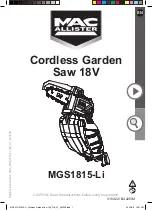
5
workpiece toward the operator.
When the blade is pinched or jammed tightly
by the kerf closing down, the blade stalls and
the motor reaction drives the unit rapidly back
toward the operator.
If the blade becomes twisted or misaligned in
the cut, the teeth at the back edge of the blade
c a n d i g i n t o t h e t o p s u r f a c e o f t h e w o o d
causing the blade to climb out of the kerf and
jump back toward the operator.
Kickback is the result of saw misuse and/or
incorrect operating procedures or conditions
a n d c a n b e a v o i d e d b y t a k i n g p r o p e r
precautions as given below:
a.
Maintain a firm grip with both hands on
the saw and position your arms to resist
kickback forces. Position your body to
either side of the blade, but not in line
with the blade.
Kickback could cause the
saw to jump backwards, but kickback forces
can be controlled by the operator, if proper
precautions are taken.
b.
W h e n b l a d e i s b i n d i n g , o r w h e n
i n t e r r u p t i n g a c u t f o r a n y r e a s o n ,
release the trigger and hold the saw
motionless in the material until the
blade comes to a complete stop. Never
attempt to remove the saw from the
work or pull the saw backward while the
b l a d e i s i n m o t i o n o r k i c k b a c k m a y
o c c u r .
I n v e s t i g a t e a n d t a k e c o r r e c t i v e
actions to eliminate the cause of blade
binding.
c.
When restarting a saw in the workpiece,
center the saw blade in the kerf so that
the saw teeth are not engaged into the
material.
If a saw blade binds, it may walk
up or kickback from the workpiece as the
saw is restarted.
d.
Support large panels to minimize the
risk of blade pinching and kickback.
Large panels tend to sag under their own
weight. Supports must be placed under the
panel on both sides, near the line of cut and
near the edge of the panel.
e.
Do not use dull or damaged blades.
U n s h a r p e n e d o r i m p r o p e r l y s e t b l a d e s
produce narrow kerf causing excessive
friction, blade binding and kickback.
f.
Blade depth and bevel adjusting locking
levers must be tight and secure before
making the cut.
If blade adjustment shifts
while cutting, it may cause binding and
kickback.
g.
Use extra caution when sawing into
existing walls or other blind areas.
The
protruding blade may cut objects that can
cause kickback.
h.
The blade washers and the bolt on your
saw have been designed to work as a
c l u t c h t o r e d u c e t h e i n t e n s i t y o f a
kickback. Understand the operation and
settings of the VARI-TORQUE CLUTCH.
The proper setting of the clutch, combined
with firm handling of the saw will allow you
to control kickback.
i.
Never place your hand behind the saw
blade.
Kickback could cause the saw to
jump backwards over your hand.
j.
Do not use the saw with an excessive
depth of cut setting.
Too much blade
exposure increases the likelihood of the
blade twisting in the kerf and increases the
s u r f a c e a r e a o f t h e b l a d e a v a i l a b l e f o r
pinching that leads to kickback.
Guard function
a.
C h e c k t h e g u a r d f o r p r o p e r c l o s i n g
before each use. Do not operate the saw
if the guard does not move freely and
enclose the blade instantly. Never clamp
or tie the guard so that the blade is
e x p o s e d .
I f t h e s a w i s a c c i d e n t a l l y
dropped, the guard may be bent. Check to
make sure that the guard moves freely and
does not touch the blade or any other part,
in all angles and depths of cut.
b.
Check the operation and condition of
the guard return spring. If the guard and
the spring are not operating properly,
they must be serviced before use.
The
g u a r d m a y o p e r a t e s l u g g i s h l y d u e t o
damaged parts, gummy deposits, or a build-
Safety Rules for Circular Saws
2610055543.qxp_GKT18V-20GC 5/26/20 4:36 PM Page 5






































